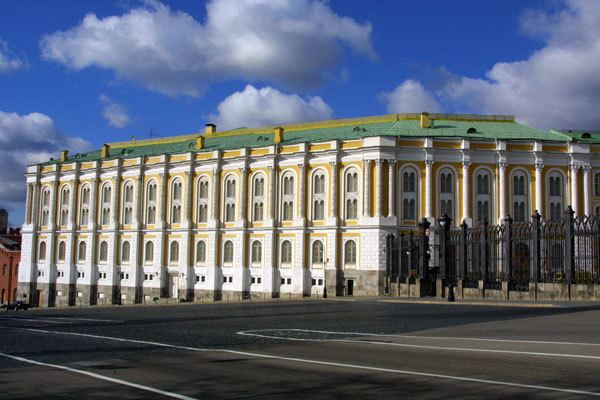Construction started 1508 Opened 1508 Architect Konstantin Thon | Phone +7 495 697-03-49 | |
 | ||
Address The Moscow Kremlin, Moskva, Russia, 103073 Hours Open today · 10AM–6PMSaturday10AM–6PMSunday10AM–6PMMonday10AM–6PMTuesday10AM–6PMWednesday10AM–6PMThursdayClosedFriday10AM–6PM Similar Moscow Kremlin, Saint Basil's Cathedral, GUM, Tsaritsyno Park, Tretyakov Gallery | ||
Moscow kremlin armoury museum
The Kremlin Armoury or Armoury Chamber (Russian: Оружейная палата) is one of the oldest museums of Moscow, established in 1808 and located in the Moscow Kremlin. The name "Armoury Chamber" is officially used by the historical-cultural museum of the Moscow Kremlin.
Contents
The Kremlin Armoury originated as the royal arsenal in 1508. Until the transfer of the court to St Petersburg, the Armoury was in charge of producing, purchasing and storing weapons, jewelry and various household articles of the tsars. The finest Muscovite gunsmiths (the Vyatkin brothers), jewelers (Gavrila Ovdokimov), and painters (Simon Ushakov) used to work there. In 1640 and 1683, they opened the iconography and pictorial studios, where the lessons on painting and handicrafts could be given. In 1700, the Armoury was enriched with the treasures of the Golden and Silver chambers of the Russian tsars.
In 1711, Peter the Great had the majority of masters transferred to his new capital, St Petersburg. 15 years later, the Armoury was merged with the Fiscal Yard (the oldest depository of the royal treasures), Stables Treasury (in charge of storing harnesses and carriages) and the Master Chamber (in charge of sewing clothes and bedclothes for the tsars). After that, the Armoury was renamed into the Arms and Master Chamber. Alexander I of Russia nominated the Armoury as the first public museum in Moscow in 1806, but the collections were not opened to the public until seven years later. The current Armoury building was erected in 1844-1851 by the imperial architect Konstantin Ton. The director of the museum from 1852 to 1870 was the writer Alexander Veltman.
After the Bolshevik Revolution, the Armoury collection was enriched with treasures taken from the Patriarch sacristy, Kremlin cathedrals, monasteries and private collections. Some of these were sold abroad on behest of Joseph Stalin in the 1930s. In 1960, the Armoury became the official museum of the Kremlin. Two years later, the Patriarch chambers and the Cathedral of the Twelve Apostles were assigned to the Armoury in order to house the Applied Arts Museum.
The Kremlin Armoury is currently home to the Russian Diamond Fund. It boasts unique collections of the Russian, Western European and Eastern applied arts spanning the period from the 5th to the 20th centuries. Some of the highlights include the Imperial Crown of Russia by jeweller Jérémie Pauzié, Monomakh's Cap, the ivory throne of Ivan the Terrible, and other regal thrones and regalia; the Orloff Diamond; the helmet of Yaroslav II; the sabres of Kuzma Minin and Dmitri Pozharski; the 12th-century necklaces from Ryazan; golden and silver tableware; articles, decorated with enamel, niello and engravings; embroidery with gold and pearls; imperial carriages, weapons, armour, and the Memory of Azov, Bouquet of Lilies Clock, Trans-Siberian Railway, Clover Leaf, Moscow Kremlin, Alexander Palace, Standart Yacht, Alexander III Equestrian, Romanov Tercentenary, Steel Military Fabergé eggs. The ten Fabergé eggs in the Armoury collection (all Imperial eggs) are the most Imperial eggs, and the second-most overall Fabergé eggs, owned by a single owner.
